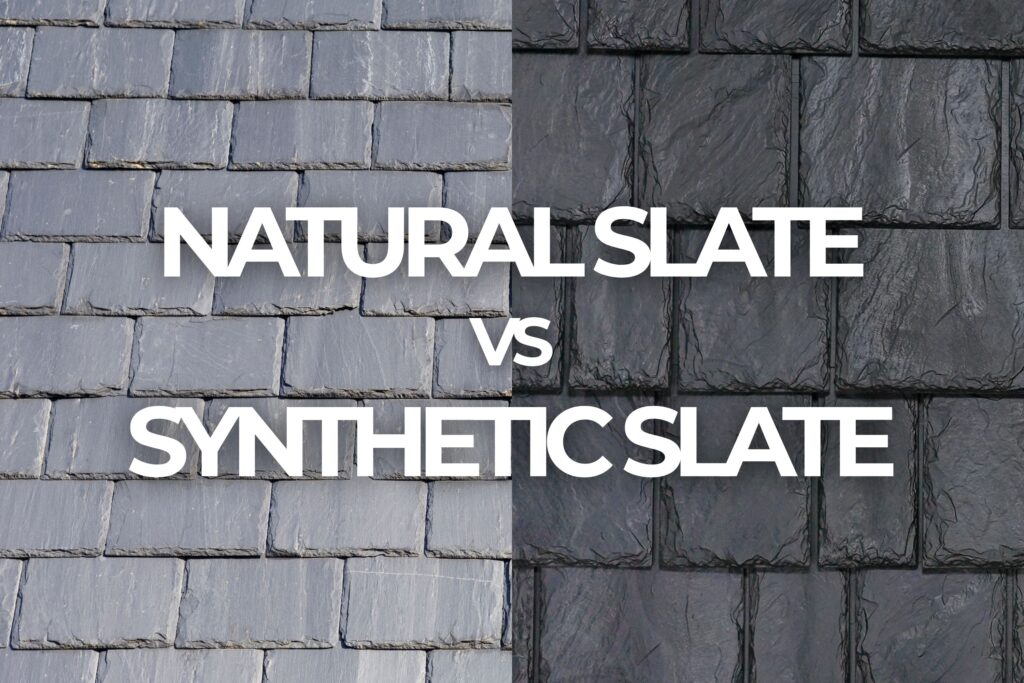Introduction
So, you’re thinking of upgrading your roof and have narrowed it down to slate—but here comes the big question: should you go with natural slate or opt for the modern synthetic slate alternative?
Both look fantastic and have their pros and cons, but the differences can affect everything from your budget and maintenance to how your home handles storms. In this guide, we’ll break it all down in plain, homeowner-friendly language to help you decide which one’s best for your place.
What is a Natural Slate Roof?
A natural slate roof is made from real, quarried stone—specifically a fine-grained metamorphic rock that splits into thin, durable sheets. These tiles have been used for centuries, and they’re known for their beautiful, timeless appeal.
Key Characteristics:
- Material: 100% natural stone
- Origin: Commonly quarried in the U.S., Spain, Brazil, and China
- Look: Elegant, rugged texture with natural color variations
- Durability: Extremely long-lasting—some roofs last over 100 years
Natural slate isn’t just pretty—it’s tough, too. But it comes with a few quirks, especially when it comes to weight and installation.
What is a Synthetic Slate Roof?
Synthetic slate, sometimes called composite or faux slate, is designed to mimic the look of natural slate but is made from a mix of rubber, plastic, or polymer composites. These materials are molded and colored to resemble real stone.
Key Characteristics:
- Material: Recycled plastics, polymers, and rubber
- Technology: UV inhibitors, impact modifiers, and fire-resistant treatments
- Look: Nearly identical to real slate from a distance
- Durability: Good—most come with warranties of 50 years or more
Synthetic slate offers a lighter, more flexible solution that installs easily, often without needing extra roof reinforcement.
Durability and Longevity
When it comes to roofing, longevity is king. Let’s see how both options measure up.
Natural Slate:
- Lifespan: 75–150 years (yes, really!)
- Resistant to: Fire, wind, UV, pests
- Needs: Occasional replacement of broken tiles
Synthetic Slate:
- Lifespan: 40–70 years (still excellent)
- Resistant to: UV rays, mold, impacts, cracking
- Needs: Lower maintenance overall
So, if you’re building your “forever home,” natural slate wins on longevity. But if you’re after long-term reliability with less fuss, synthetic might be more practical.
| Cost Factor | Natural Slate | Synthetic Slate |
| Material Price | $10–$20 per sq. ft | $4–$8 per sq. ft |
| Installation Cost | High (needs specialists) | Moderate |
| Roof Reinforcement | Often Required | Usually Not Needed |
| Long-Term Maintenance | Moderate | Low |
Aesthetic and Curb Appeal
Both options are stunning, but in different ways.
- Natural Slate: Offers a classic, high-end look with subtle variations in texture and color that no factory can fully replicate.
- Synthetic Slate: Available in a wide range of uniform styles and colors. Looks great from the street but may look slightly less “authentic” up close.
For resale value and “wow factor,” both are appealing, but purists often lean toward the real thing.
Installation and Structural Requirements
Natural slate is heavy—up to 1,500 lbs per 100 square feet—and not every home is built to handle that load. Retrofitting may require reinforcing the roof deck, which adds cost and complexity.
Synthetic slate, on the other hand, is much lighter and easier to work with. It can often be installed on existing roofs without structural changes.
Environmental Impact
Which is greener?
- Natural Slate: It’s natural and lasts a long time, which is great. However, quarrying and transporting heavy stone has a higher carbon footprint.
- Synthetic Slate: Often made from recycled materials and requires less energy to install and transport. Bonus: some are recyclable themselves.
In short, synthetic may have a smaller environmental footprint in many cases.
Fire and Impact Resistance
- Natural Slate: Naturally fireproof and highly resistant to hail or debris.
- Synthetic Slate: Usually treated to be fire-resistant and many are Class 4 impact rated, which means great hail protection.
Both do well in tough weather, but always check product ratings for synthetic brands.
Warranty and Manufacturer Support
- Natural Slate: Rarely comes with a manufacturer warranty—you’re relying on the installer and the rock’s inherent durability.
- Synthetic Slate: Most come with 50-year transferable warranties, which can be a big plus if you plan to sell.
Value Addition to Your Property
A slate roof—natural or synthetic—can add value to your home. It signals quality, durability, and aesthetic charm.
- Natural Slate: Greater historical and architectural appeal
- Synthetic Slate: Still boosts value, and makes newer homes look upscale
Buyers love the idea of “never replacing the roof again,” so either choice can be a big resale plus.
| Feature | Natural Slate | Synthetic Slate |
| Lifespan | 75–150 years | 40–70 years |
| Cost | High | Moderate |
| Weight | Very Heavy | Lightweight |
| Maintenance | Medium | Low |
| Look | Authentic & Unique | Consistently Attractive |
| Installation | Complex & Expensive | Easier & Faster |
| Eco-friendliness | Natural Material | Often Recycled Content |
| Warranty | Rare | Common (up to 50 years) |
Real-Life Case Study: A Homeowner’s Decision
Take Mike and Sarah in upstate New York. They were remodeling their 1930s Tudor and wanted to preserve its historic charm.
Initially, they leaned toward natural slate. But after learning their roof structure would need $10,000 in reinforcement, they went with high-end synthetic tiles that mimicked slate beautifully.
“Most of our neighbors thought it was real slate,” says Mike. “And we saved enough to redo our gutters and insulation too.”
Expert Opinions and Recommendations
Roofing contractor Jenna Fields of Evergreen Exteriors shares:
“If you’re restoring a historic home or never plan to move, real slate is amazing. But for most homeowners, today’s synthetic options give you 90% of the benefits at 50% of the cost.”
FAQs
Q1: Can I install synthetic slate over my existing roof?
A: Sometimes yes, if your current roof is in good shape. Always consult a contractor.
Q2: Does synthetic slate look fake?
A: High-quality brands look very convincing—even up close.
Q3: Is natural slate fragile?
A: It’s strong but can crack under heavy impact. Proper installation is key.
Q4: Will either option affect my home insurance?
A: Some insurers offer discounts for impact-resistant synthetic roofs.
Q5: Which is better for resale?
A: Both add value, but natural slate may be more appealing in historic or luxury markets.
Q6: How long does installation take?
A: Natural slate can take 2–3x longer to install than synthetic due to weight and complexity.
Conclusion
So, synthetic slate roof vs natural slate roof—what’s the verdict?
- Choose natural slate if you want unmatched authenticity, have the budget, and plan to stay in your home for decades.
- Go with synthetic slate if you want the look of slate without the cost, weight, and maintenance headaches.
Either way, you’re choosing a roof that brings beauty and value to your home.




